Unlock the Secret to Perfect Creamy Polenta: Your Go-To Recipe for Any Meal
Creamy Polenta is a truly versatile and comforting dish, celebrated for its velvety texture and rich, comforting flavor. This traditional Italian staple transcends being just a simple side, capable of standing proudly as a satisfying main course or complementing a wide array of hearty dishes. Its rustic charm and inherent deliciousness have made it a favorite in homes and restaurants worldwide, offering a taste of authentic Italian culinary tradition that is both elegant and incredibly approachable.
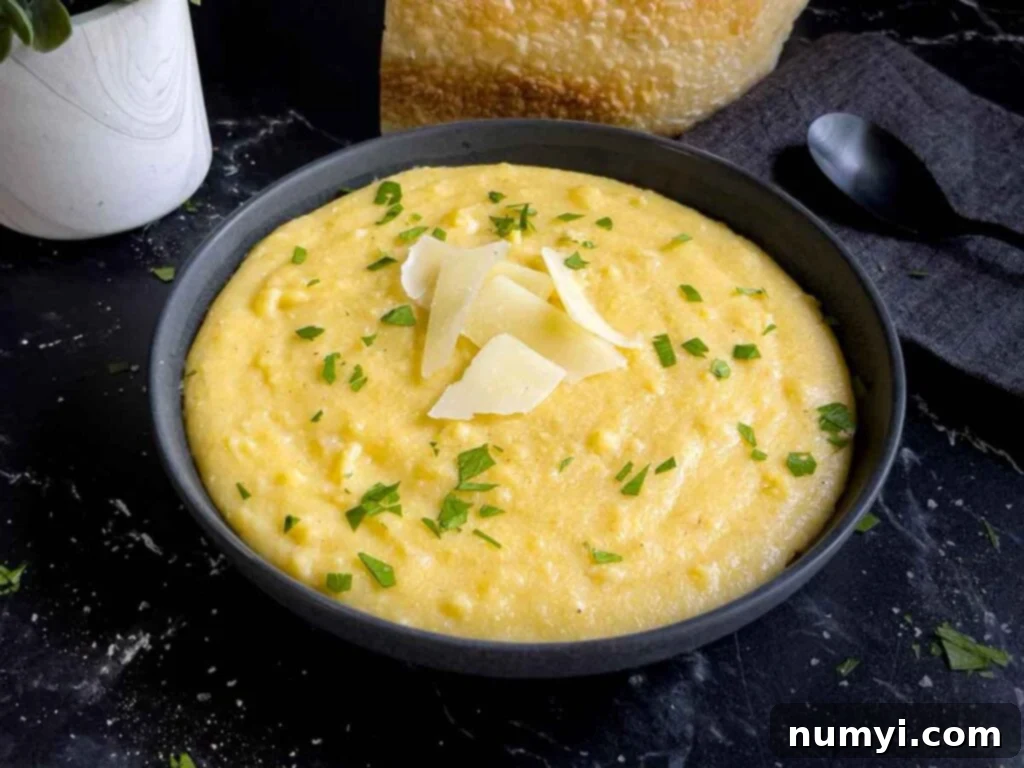
Why You Will Love This Creamy Polenta Recipe
Prepare to fall in love with the delightful sweet corn flavor that shines through in this simple yet incredibly satisfying polenta recipe. It’s a foundational dish, expertly crafted to highlight the natural essence of corn in its purest form. This recipe proves that you don’t need a lengthy ingredient list or complex techniques to achieve an intensely flavorful and deeply satisfying meal.
With just a few common ingredients and straightforward steps, this creamy polenta is an ideal choice for busy weeknights, effortless entertaining, or whenever you crave a fuss-free yet undeniably delicious and heartwarming dish. Its simple elegance makes it a versatile addition to your culinary repertoire.
While wonderfully delicious enjoyed on its own, this polenta truly excels as a sublime accompaniment to richer, more substantial dishes. Imagine serving it alongside succulent, slow-cooked meats, such as our amazing braised beef cheeks – the creamy texture of the polenta perfectly balances the robust flavors of the beef, creating a truly unforgettable dining experience. Its ability to absorb and enhance the flavors of whatever it’s paired with is part of its undeniable charm.
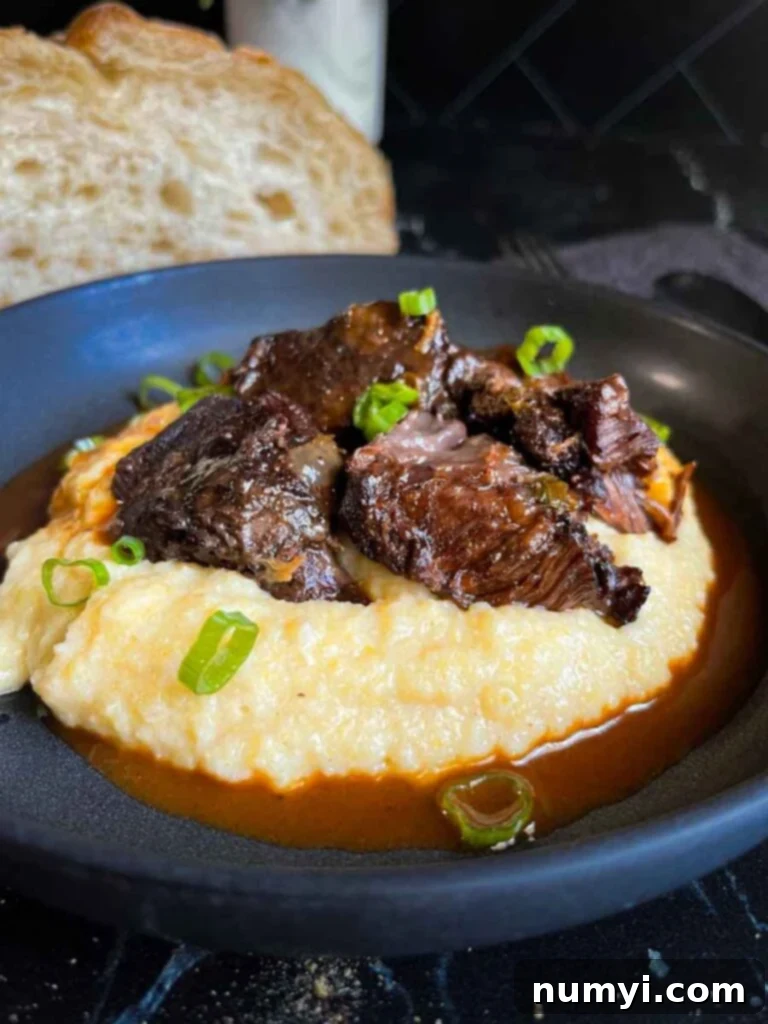
Embrace the inherent simplicity of this recipe and allow the sweet, earthy flavor of the corn to take center stage, bringing comfort and satisfaction with every creamy spoonful. It’s more than just food; it’s a culinary hug.
What’s The Difference Between Polenta And Grits?
Polenta and grits, though often confused due to their similar appearance as corn-based porridges, are distinct dishes with their own unique characteristics and deep roots in different culinary traditions. Understanding these differences can elevate your appreciation for both.
Polenta is a time-honored traditional dish from northern Italy, made by cooking coarse ground yellow cornmeal with water, milk, or stock until it achieves a wonderfully creamy, thick consistency. For centuries, polenta has been a staple in regions such as Lombardy, Piedmont, and Veneto, where it served as a fundamental food source. It is most commonly served as a versatile side dish, offering a neutral yet flavorful base for rich sauces like ragù, grilled meats, or an assortment of roasted and sautéed vegetables. Its texture tends to be slightly coarser and more substantial due to the grind of cornmeal used.
On the other hand, grits are an iconic dish deeply embedded in the culinary heritage of the Southern United States. They are typically made from a finer grind of white cornmeal, often derived from hominy (corn kernels that have been treated with an alkali process to remove the hull). This process imparts a distinct flavor and a smoother, more uniform texture to the grits. In Southern cuisine, grits are frequently enjoyed as a breakfast staple, generously topped with butter, cheese, or savory additions like shrimp, bacon, or fried fish. While they can also accompany dinner, their role as a breakfast item is primary.
The primary distinction between polenta and grits lies in two key factors: the specific type and grind of cornmeal utilized, and the regional culinary traditions that have shaped their preparation and consumption.
While polenta traditionally uses coarsely ground yellow cornmeal, which lends itself to a heartier, somewhat granular consistency, grits typically employ a finer grind of white cornmeal, often hominy grits. Hominy is dried corn that has undergone nixtamalization, a process that removes the outer hull and makes the corn more nutritious and flavorful. This treatment gives hominy grits their characteristic smooth texture and unique taste profile.
These variations in cornmeal and processing directly contribute to the contrasting textures and subtle flavor nuances between the two dishes. Polenta offers a rustic and more toothsome mouthfeel, often described as having a pleasant “bite,” while grits are renowned for their ultra-creamy, velvety, and almost melt-in-your-mouth consistency. Both, however, are celebrated for their ability to provide comforting, corn-based satisfaction.
Essential Ingredients Needed for Creamy Polenta

One of the beauties of this creamy polenta recipe is its reliance on readily available and inexpensive ingredients, transforming humble components into a truly fabulous dish. The magic lies in how these simple elements combine to create a symphony of flavors and textures.
- Coarse Ground Yellow Cornmeal: This is the absolute star of our creamy polenta. The coarse grind is crucial for achieving polenta’s signature hearty texture, offering a comforting corn flavor that forms the dish’s backbone. Be sure to use a good quality, coarse-ground variety for the best results, not instant or fine cornmeal designed for baking.
- Chicken Stock: Far more than just liquid, chicken stock is essential for infusing the polenta with deep, savory notes and a rich umami complexity. It creates a flavorful base that elevates the dish beyond a simple corn porridge. For a vegetarian option, a good quality vegetable stock works beautifully.
- Olive Oil: Used to sauté our aromatics, good quality olive oil adds a subtle fruitiness and a touch of Mediterranean richness to the polenta. It also plays a practical role in preventing sticking and helping to achieve a smoother consistency.
- Onion: When diced and patiently sautéed until tender and translucent, the onion contributes a delicate sweetness and foundational depth of flavor. It caramelizes slightly, complementing the cornmeal beautifully and building a robust taste profile.
- Garlic: Aromatic and pungent, fresh minced garlic brings a bold, savory element that brightens the polenta’s overall taste. It’s a classic pairing with onion and adds a layer of irresistible flavor.
- Parmesan Cheese (Parmigiano-Reggiano): The addition of freshly grated Parmesan cheese introduces a luxurious creaminess, a delightful nutty tang, and a significant boost of umami. This hard, aged cheese is fundamental to achieving the authentic Italian flavor and velvety texture. Feel free to substitute with Pecorino Romano for a sharper, saltier kick if preferred.
- Unsalted Butter: Generous amounts of butter are non-negotiable for achieving that incredibly rich, silky smooth texture and indulgent mouthfeel. It melts into the polenta, adding a depth of flavor and a luscious finish that truly makes it “creamy.” Always opt for real butter, not margarine, for the best taste and texture.
- Salt and Freshly Ground Black Pepper: These humble seasonings are absolutely critical. They are not merely afterthoughts but essential for balancing and enhancing all the other flavors, ensuring your polenta is perfectly seasoned and harmonizes beautifully. Taste as you go and adjust to your preference.
How To Make Irresistibly Creamy Polenta
Creating perfect creamy polenta is a rewarding culinary experience that requires a little patience but delivers immense satisfaction. Follow these steps for a truly delicious result.
Step 1: Sauté the Aromatics
Begin by heating the olive oil in a large, heavy-bottomed pot over medium to medium-high heat. A heavy pot is crucial here to ensure even heat distribution and prevent the polenta from sticking later on. Once the oil is shimmering, add the diced onions to the pot. Sauté them gently, stirring occasionally, until they become soft, translucent, and just begin to caramelize around the edges, which typically takes about 5-7 minutes. This slow cooking develops their natural sweetness. Be mindful not to burn them, but a little browning adds depth of flavor.
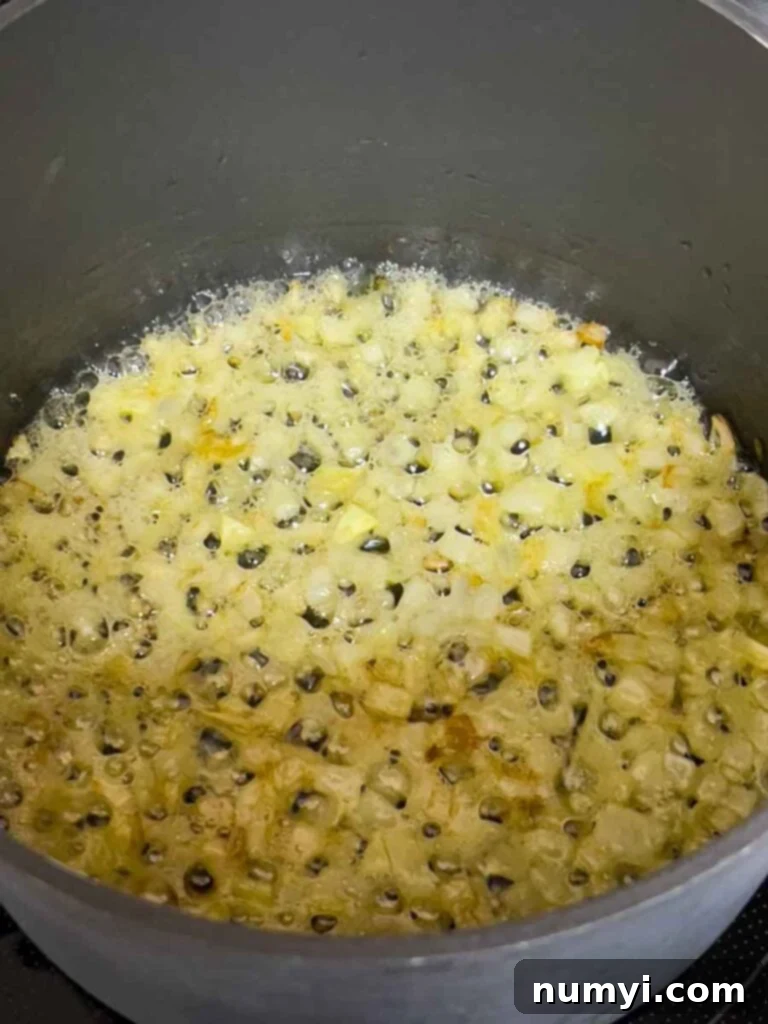
Next, reduce the heat to medium-low and add the minced garlic. Continue to cook, stirring constantly, for about 1 minute, or until the garlic becomes fragrant. It’s important not to overcook the garlic, as it can quickly burn and turn bitter.
Step 2: Bring the Stock to a Boil
Pour the chicken stock into the pot with the sautéed aromatics. Increase the heat to medium-high and bring the stock to a rolling boil. This ensures that when you add the cornmeal, it begins to cook immediately and evenly.
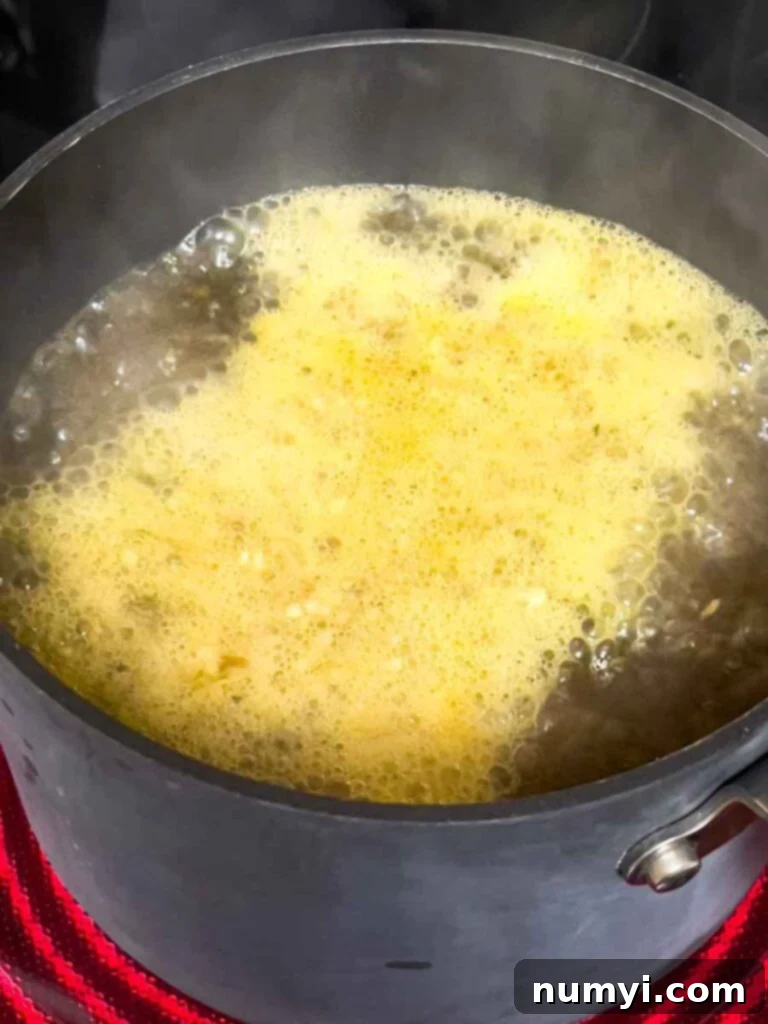
Step 3: Gradually Add Cornmeal and Whisk
This is a critical step for achieving lump-free, creamy polenta. Begin to slowly pour the cornmeal into the boiling stock in a thin, steady stream. As you pour, vigorously whisk the mixture continuously. A vigorous whisk will prevent any lumps from forming, ensuring a perfectly smooth texture from the start. Continue whisking until all the cornmeal is incorporated and the mixture thickens slightly.
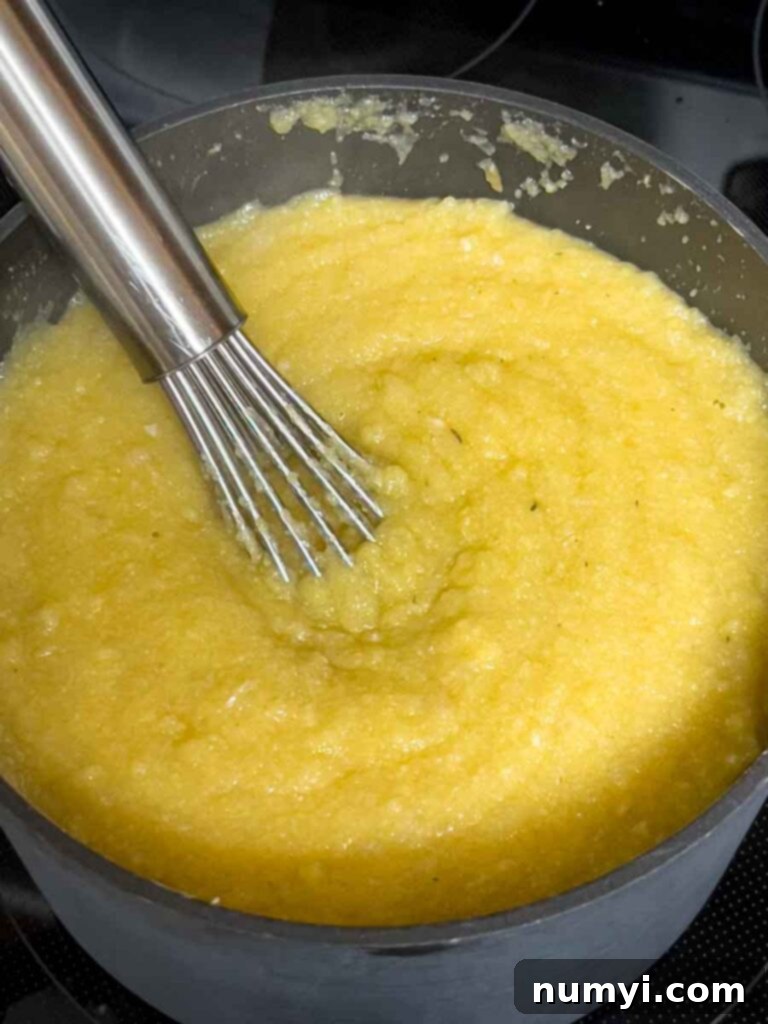
Step 4: Simmer and Stir
Reduce the heat to low or medium-low to maintain a gentle simmer. Continue to cook the polenta for 15 to 20 minutes, stirring frequently (every few minutes is ideal). A sturdy wooden spoon is excellent for this. Frequent stirring is essential to prevent the polenta from sticking to the bottom of the pot and to encourage the starches to release, which is what creates that desired creamy consistency. The polenta should thicken and become smooth. Taste a small spoonful to test for doneness; it should be tender, creamy, and free of any raw, gritty taste.
Step 5: Finish with Cheese and Butter
Once the polenta has reached your preferred creamy consistency and is fully cooked, remove the pot from the heat. Stir in the freshly grated Parmesan cheese until it is fully melted and incorporated, adding its characteristic salty, nutty, and umami flavors.
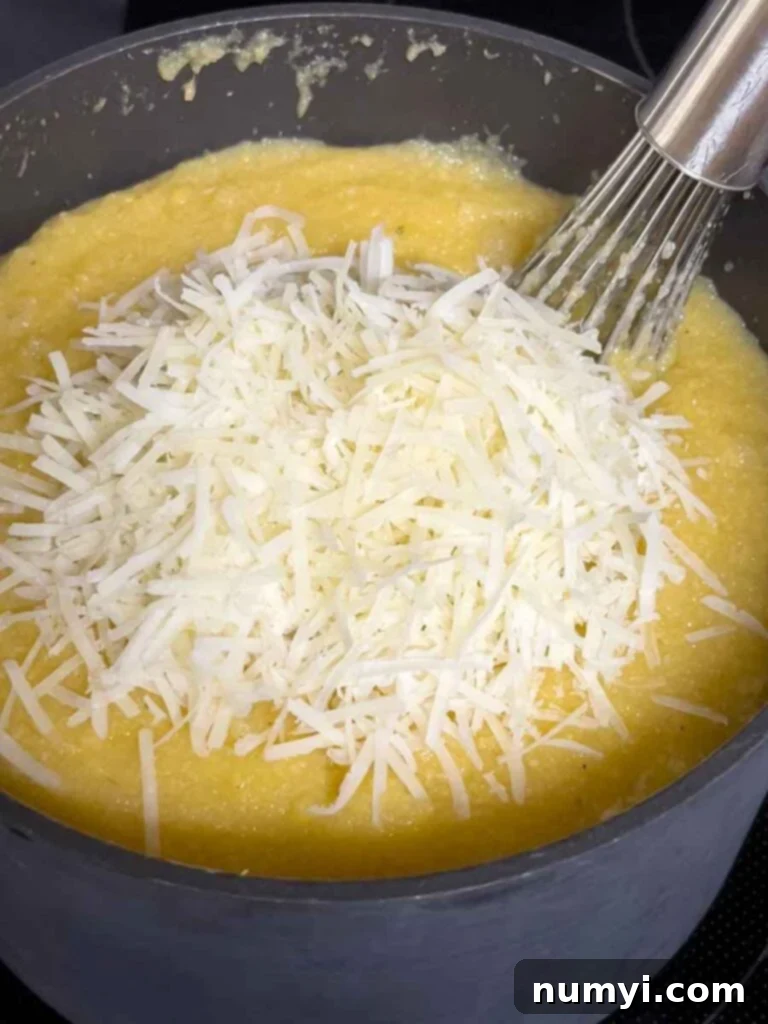
Finally, add the cold butter, stirring it vigorously until it completely melts and is absorbed into the polenta. The butter contributes significantly to the dish’s luxurious richness and velvety texture. Taste the polenta again and season generously with salt and freshly ground black pepper to your preference. Remember that the chicken stock and Parmesan already contribute salt, so adjust carefully.
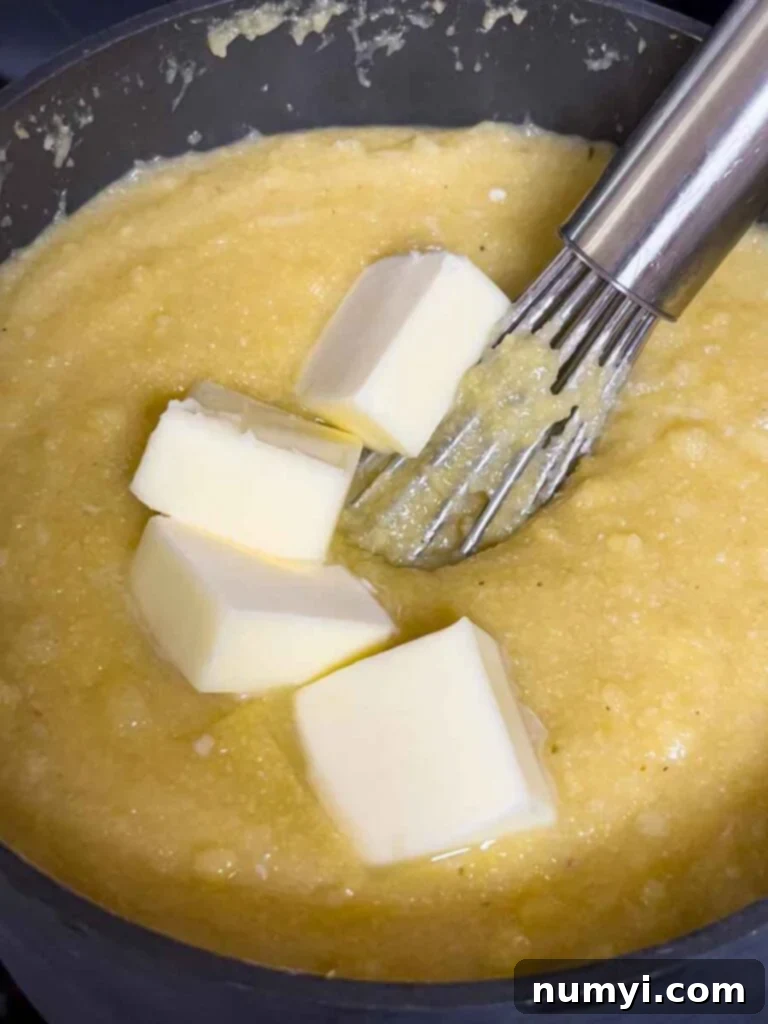
Step 6: Serve and Garnish
Once everything is fully incorporated and the polenta is gloriously creamy, remove it from the heat and serve immediately while hot. Garnish with a sprinkle of fresh chopped parsley for a pop of color and freshness, and an extra dusting of Parmesan cheese, if desired. This simple recipe proves that delicious dishes don’t have to be complicated! It’s so easy and so good, it will quickly become one of your favorite go-to recipes!
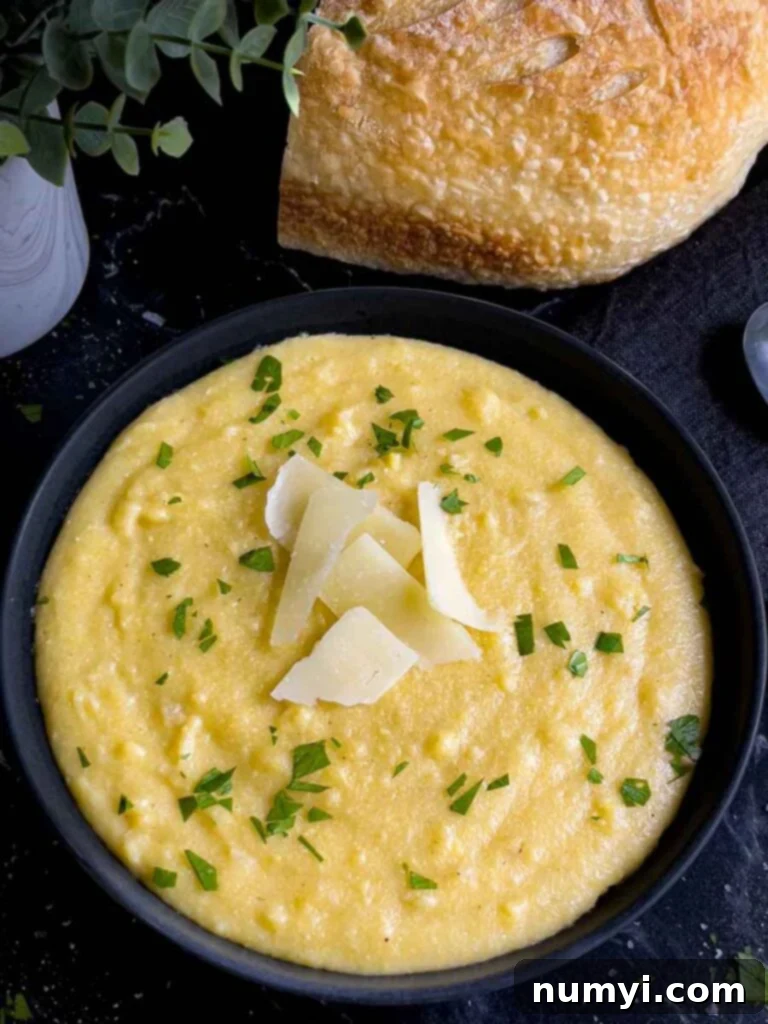
Tips, Tricks, and Delicious Variations for Polenta
Mastering creamy polenta is easy with a few key tips, and its versatility means you can adapt it to countless flavor profiles. Here are some ways to perfect your polenta and explore exciting new variations:
- Achieving Your Ideal Consistency: This recipe yields a wonderfully creamy polenta, but personal preferences vary. If you find it too thick for your liking, don’t hesitate to add a splash more warm chicken stock, water, or even milk/cream, stirring it in until you reach your desired consistency. Conversely, if it’s too thin, continue to cook and stir on low heat for a few more minutes until it thickens. The “best” texture is ultimately your personal favorite!
- Gradually Add the Cornmeal (The Golden Rule): This is perhaps the most crucial tip for lump-free polenta. When incorporating the cornmeal into the hot liquid, always add it gradually in a slow, steady stream while continuously and vigorously whisking. This action prevents lumps from forming, allowing the cornmeal to absorb the liquid evenly and swell, resulting in a perfectly smooth, velvety consistency every single time.
- Stir Frequently (The Polenta Dance): Polenta demands your attention during cooking. Regular stirring throughout the entire cooking process is essential. This not only prevents it from sticking to the bottom of your pot (which can easily happen with starchy grains) but also helps to release the starches from the cornmeal, which is what contributes to that coveted creamy texture. Aim to stir every few minutes, especially as it thickens, to keep it smooth and prevent scorching.
- Herb-infused Polenta: Elevate the aromatic profile of your polenta by incorporating fresh herbs. Along with the initial sautéed onions and garlic, add a tablespoon of finely chopped fresh herbs such as rosemary, thyme, or sage. These herbs will gently infuse the dish with their earthy, fragrant notes as the polenta cooks, adding a sophisticated layer of flavor.
- Creamy Mushroom Polenta: Transform your polenta into a hearty meal by serving it with a savory mushroom topping. While your polenta is simmering, sauté a mixture of sliced mushrooms (cremini, shiitake, or wild mushrooms work wonderfully) with a knob of butter and a clove of minced garlic. Season with salt, pepper, and a splash of white wine or vegetable broth for extra depth. Spoon this rich mushroom medley over the hot creamy polenta for an incredibly satisfying dish.
- Tomato and Basil Polenta: For a vibrant and fresh twist, add a Mediterranean touch. Stir in a tablespoon of concentrated tomato paste into the polenta during the cooking process. Once cooked and off the heat, fold in a generous handful of fresh chopped basil leaves. The tomato paste will lend a rich, umami depth, while the fresh basil provides bright, aromatic notes. Serve alongside roasted cherry tomatoes or a simple marinara sauce for a colorful and flavorful presentation.
- Cheesy Polenta Extravaganza: Beyond Parmesan, polenta welcomes other cheeses. Experiment by stirring in cheeses like gorgonzola (for a pungent kick), fontina (for an incredibly melty, mild flavor), or even a sharp cheddar for a more Americanized comfort food take. Add these in at the very end with the butter for the best melt.
- Spicy Polenta: For those who love a bit of heat, consider adding a pinch of red chili flakes to the olive oil when sautéing the onions. A dash of hot sauce or finely minced jalapeño can also be stirred in at the end for an extra fiery kick.
- Grilled or Fried Polenta (Leftovers Transformed): Don’t let leftover polenta go to waste! Pour cooled, firm polenta into a shallow dish, allow it to set in the fridge, then cut it into squares or rounds. These can be grilled, pan-fried, or baked until crispy and golden. Serve these crispy polenta pieces with sauces, roasted vegetables, or as a base for appetizers.
- Sweet Breakfast Polenta: While typically savory, polenta can be wonderful as a sweet breakfast. Cook it with milk (or a dairy-free alternative) instead of stock, omit the savory aromatics, and sweeten with honey or maple syrup. Serve with fresh berries, nuts, and a drizzle of cream.
Frequently Asked Questions About Creamy Polenta
Polenta is typically made with coarser ground yellow cornmeal and originates from Italian cuisine, while grits are made with finer ground white cornmeal (often hominy) and are a beloved staple of Southern American cooking. They differ in texture and traditional usage.
No, polenta is the name of the cooked dish made from cornmeal, whereas cornmeal is the raw, ground corn ingredient itself. Polenta specifically refers to the porridge-like preparation.
Quick-cooking or instant polenta is a fine-grained variety that cooks much faster. While convenient, it will result in a smoother texture and may lack the robust flavor of traditional coarse polenta. For the best flavor and authentic texture, traditional coarse polenta is recommended, allowing for the longer cooking time.
Absolutely! Leftover polenta tends to firm up considerably as it cools. When reheating, you’ll need to add a little liquid (water, broth, or milk) and stir it over low heat on the stovetop or in the microwave until it regains its creamy consistency. Don’t be afraid to add a generous splash of liquid.
A large, heavy-bottomed pot or Dutch oven is ideal for cooking polenta. The heavy base helps distribute heat evenly, which is crucial for preventing the polenta from sticking and scorching, especially during the long simmering and stirring process.
Yes, polenta can be made ahead. Once cooked, pour it into a lightly oiled baking dish or loaf pan and let it cool completely until firm. You can then cut it into shapes (squares, rounds) and pan-fry, grill, or bake the individual pieces just before serving. For creamy polenta, it’s best served fresh, but if reheating a creamy batch, add extra liquid as mentioned above.
Other Delicious Side Dishes You’ll Love
Fast And Delicious Mashed Potatoes Recipe
Creamy Mushroom Risotto
Baked Macaroni And Cheese
Are you on Pinterest? Click the button below to add this recipe to one of your boards!

Creamy Polenta Recipe
Enjoy the rich flavors of Creamy Polenta. Made using yellow cornmeal, onion, garlic, chicken stock, butter, and Parmesan cheese. Pure satisfaction in every bite!
5 from 1 vote
Pin
Rate
Ingredients
- 2 cups Cornmeal
- 6 cups Chicken stock
- 1 tbsp Olive oil
- 1/2 cup Onion (diced, approx. 1/2 onion)
- 2 cloves Garlic (minced, about 1 tbsp)
- 1/2 cup Parmesan cheese (shredded)
- 4 tbsp Butter
- Salt and pepper (to taste)
Instructions
- Heat the olive oil in a large pot over medium heat.
- Add the diced onions to the pot and sauté until they start to turn translucent, about 5-7 minutes.
- Add the garlic. Continue to cook until the garlic becomes fragrant, about 1 minute.
- Add the chicken stock to the pot and bring to a boil.
- Pour the cornmeal in, whisking vigorously as you add the cornmeal. A vigorous whisk will prevent clumping.
- Drop the heat to medium-low and continue whisking to ensure that no clumps are forming.
- Continue to cook on medium-low heat for 15 to 20 minutes, stirring occasionally.
- Add the Parmesan cheese. Stir to incorporate fully.
- Add the butter and stir to incorporate fully.
- Optionally, season with salt and pepper to taste.
Notes
If you have leftover polenta, allow it to cool to room temperature before refrigerating. Transfer the polenta to an airtight container or cover it tightly with plastic wrap. Place the container in the refrigerator, where the polenta can be stored for around 4 to 5 days.
Freezing: Make sure the cooked polenta has completely cooled down before dividing it into portion-sized servings, if desired. Place the polenta in airtight freezer bags or containers, ensuring to remove as much air as possible to prevent freezer burn. Label the bags or containers with the date to keep track of the freezing time. Frozen polenta can be stored for up to 3 months.
Reheating: Polenta tends to firm up as it cools, so when reheating, you may need to add a little liquid, such as water or broth, and stir until it reaches a creamy consistency again. Reheating can be done on the stovetop or in the microwave.
Nutrition
Carbohydrates: 37g |
Protein: 11g |
Fat: 14g |
Saturated Fat: 6g |
Polyunsaturated Fat: 2g |
Monounsaturated Fat: 5g |
Trans Fat: 0.2g |
Cholesterol: 25mg |
Sodium: 405mg |
Potassium: 342mg |
Fiber: 4g |
Sugar: 4g |
Vitamin A: 229IU |
Vitamin C: 1mg |
Calcium: 87mg |
Iron: 2mg
